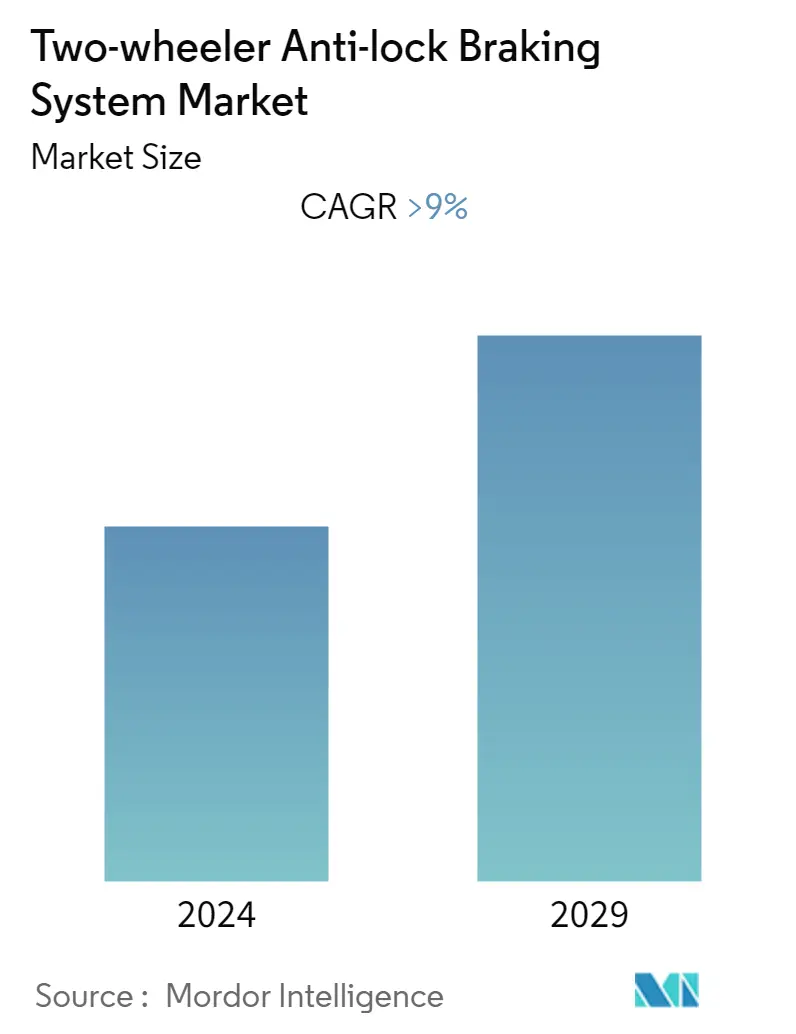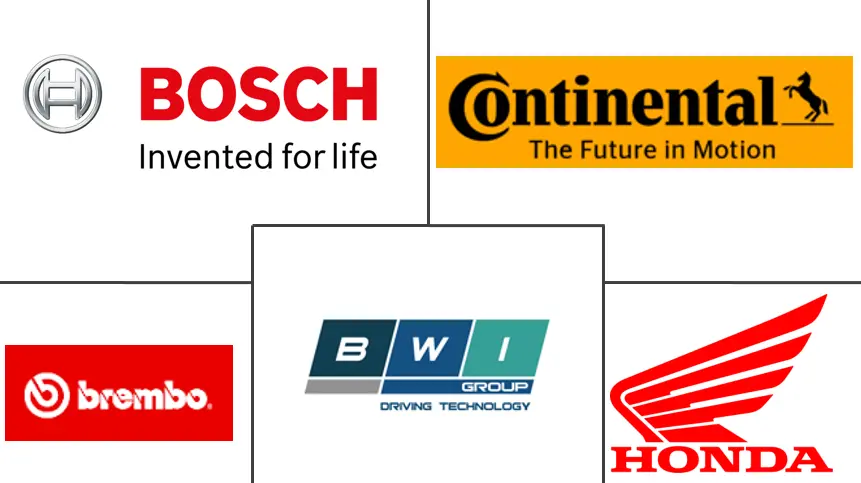Market Size of Two-wheeler Anti-lock Braking System Industry

| Study Period | 2019 - 2029 |
| Base Year For Estimation | 2023 |
| CAGR | > 9.00 % |
| Fastest Growing Market | Asia Pacific |
| Largest Market | Asia Pacific |
| Market Concentration | Medium |
Major Players
*Disclaimer: Major Players sorted in no particular order |
Two Wheeler Anti Lock Braking System Market Analysis
The global two-wheeler ABS market is anticipated to register a CAGR of about 9% during the forecast period (2020 - 2025).
- According to the Insurance Institute for Highway Safety (IIHS), fatal crashes can be reduced by 31% for motorcycles equipped with optional ABS compared to those same models without ABS.
- Increasing road traffic and congestion, the low maintenance cost of bikes, people's willingness to buy 2 wheelers are some of the factors which are driving the global 2-wheeler ABS market.
- The governments are imposing strict regulations for reductions in fatalities during road accidents, for instance, the European Union parliament mandated anti-lock braking systems as the standard equipment in motorcycles built from 2016. The Insurance Institute of Highway Safety reported that 8.9% of registered motorcycles were required to have anti-lock brake systems in 2017. This number increased steadily since 2002 when anti-lock brake technology was considered a standard form of equipment on only 0.2% of motorcycles.
- The modern electronics of brake systems offer motorcyclists more safety, and on onus with that make driving much more comfortable. Some of the other benefits of ABS are provided stable braking characteristics on all road surfaces, maintains steerability, and reduces the braking distance, which reduces tire wear and tear.
Two Wheeler Anti Lock Braking System Industry Segmentation
The global two-wheeler ABS market covers the latest trends in the two-wheeler ABS market, complete supply chain, and market share of major two-wheeler ABS providers across the world.
| By Type | |
| Single channel | |
| Dual channel |
| By Two-wheeler Type | |
| Motorcycle | |
| Scooter |
| By Propulsion Type | |
| IC Engine | |
| Electric |
| By Displacement Type | |
| less than 125 | |
| 126-250cc | |
| 251-400cc | |
| above 400cc |
| By Component Type | |
| ECU | |
| Sensors | |
| Hydraulic Pump | |
| Solenoid Valve |
Two-wheeler Anti-lock Braking System Market Size Summary
The global two-wheeler anti-lock braking system (ABS) market is experiencing significant growth, driven by increasing road traffic, the low maintenance costs of bikes, and a rising willingness among consumers to purchase two-wheelers. The market is further propelled by stringent government regulations aimed at reducing road accident fatalities, such as the European Union's mandate for ABS as standard equipment in motorcycles since 2016. This trend is mirrored in other regions, with countries like Japan and India implementing similar regulations to enhance safety standards. The modern electronics integrated into brake systems not only offer improved safety but also enhance driving comfort by providing stable braking characteristics, maintaining steerability, and reducing braking distances.
Europe holds a substantial share of the global two-wheeler ABS market, being one of the first regions to make ABS compulsory. The region's market is characterized by significant motorcycle registrations, with countries like Italy, France, and Spain leading in sales. Meanwhile, the Asia Pacific region, particularly China, India, and Japan, is anticipated to witness rapid growth, influenced by its status as a major market for two-wheelers. Local governments in these countries are also enforcing ABS regulations, with India mandating ABS for all new two-wheelers over 125cc. The market is dominated by key players such as Robert Bosch GmbH, Autoliv Inc., and Continental Reifen Deutschland GmbH, who are actively investing in technology and expanding production capacities to meet the growing demand for ABS in both two-wheelers and passenger vehicles.
Two-wheeler Anti-lock Braking System Market Size - Table of Contents
-
1. MARKET DYNAMICS
-
1.1 Market Drivers
-
1.2 Market Restraints
-
1.3 Industry Attractiveness - Porter's Five Forces Analysis
-
1.3.1 Threat of New Entrants
-
1.3.2 Bargaining Power of Buyers/Consumers
-
1.3.3 Bargaining Power of Suppliers
-
1.3.4 Threat of Substitute Products
-
1.3.5 Intensity of Competitive Rivalry
-
-
-
2. MARKET SEGMENTATION
-
2.1 By Type
-
2.1.1 Single channel
-
2.1.2 Dual channel
-
-
2.2 By Two-wheeler Type
-
2.2.1 Motorcycle
-
2.2.2 Scooter
-
-
2.3 By Propulsion Type
-
2.3.1 IC Engine
-
2.3.2 Electric
-
-
2.4 By Displacement Type
-
2.4.1 less than 125
-
2.4.2 126-250cc
-
2.4.3 251-400cc
-
2.4.4 above 400cc
-
-
2.5 By Component Type
-
2.5.1 ECU
-
2.5.2 Sensors
-
2.5.3 Hydraulic Pump
-
2.5.4 Solenoid Valve
-
-
Two-wheeler Anti-lock Braking System Market Size FAQs
What is the current Two-wheeler Anti-lock Braking System Market size?
The Two-wheeler Anti-lock Braking System Market is projected to register a CAGR of greater than 9% during the forecast period (2024-2029)
Who are the key players in Two-wheeler Anti-lock Braking System Market?
Robert Bosch GmbH, Continental AG, Brembo S.p.A, BWI Group and Honda Motor Company, Ltd are the major companies operating in the Two-wheeler Anti-lock Braking System Market.

